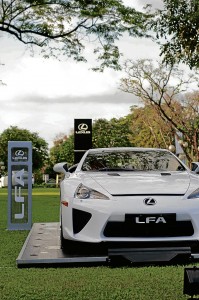Lexus dominates US, PH
A wild cat or a prancing horse it is not. It also isn’t a star or a stripe. Nor is it an “old” brand in the sense that it’s backed up by decades of automotive heritage. It is young, and perhaps because of that, it is daring enough to charge conventions head-on and shake up the luxury brand market. And not just in any market, but in the ultimate arena of everything that is automotive, where having a car isn’t just a necessity, but a fashion statement, status symbol, badge of honor and a license to get fast-tracked to the American dream. It may not have been rooted in the land of milk and honey, but its insignia could ultimately end up as the logo for “luxury”.
Sigh, if you still didn’t get it, here it is, served on a silver platter: Lexus.
Lexus, Toyota’s luxurious sister, first appeared in the United States in 1989.
You got it right. What Japan failed to achieve in war, it succeeded with cars, cartoons, the Walkman and Godzilla (in no particular order). Japanese workmanship, creativity and innovation conquered the United States. And like clockwork, where Uncle Sam went, so did its “BFF,” the Philippines. In other words, Lexus devoured its competition in the United States, and then went for second helpings in the Philippines three years ago.
In fact, it was a virtual “buffet” for Lexus as it was introduced in more than 70 countries and territories.
The birth of Lexus in the United States, however, was taken a bit too lightly by the public. “When, in the early 1980s, word leaked out that Toyota was thinking of contesting the luxury-car market and challenging the likes of Mercedes-Benz and even Rolls-Royce, the only people to take the rumours seriously were the financial analysts. They knew that the Japanese company, although associated in the public mind with uninspiring cars for people not really interested in cars or driving, was highly ambitious, financially rock solid and extremely thorough,” quipped auto expert Tony Lewin.
Lewin added that Toyota did, indeed, throw huge resources at the project, codenamed F1 or Flagship One, by interviewing thousands of potential customers, stripping down every luxury car and even replicating several kilometers of the Autobahn on its test track in Japan so that the prototypes could be evaluated in German conditions. Lewin, a former editor of What Car? Magazine who has over three decades of experience in automotive writing, also authored the “AZ of 21st Century Cars”.
During those “olden” days when the US market thought Japanese cars were functional but “uninspired,” Yukiyasu Togo, who would become president of Toyota Motor Sales USA, once envisioned producing luxury cars Americans would dream of.
According to auto historian Masaaki Sato, Toyota finally introduced Lexus in 1989, and rather than unveil it first in Japan, the masterstroke was that Toyota did it in the United States.
The luxury vehicles produced in the States had long been positioned as “cars driven by achievers of the American dream,” and thus carried dignity and composure. Sato mentioned traditional brand names such as the GM Cadillac and the Ford Lincoln, which “stood unrivaled in the market, and drivers tolerated small failures.” Sato, who authored the book “The Toyota Leaders” translated by Justin Bonsey, also related how the rise of the concept of fuel efficiency shook the foundations of these traditional brands, writing, “the emerging wealth class was also changing, shying away from overbearing designs and instead tending heavily towards German luxury vehicles that emphasized functionality, such as Mercedes-Benz and BMW.”
Sato explained that it was in this period of flux, when luxury began to adapt to the impetus of functionality, that the R&D team of Toyota set itself down to work, to design luxury vehicles on a new notion: Functionality equivalent to German luxury vehicles, with the quality and reliability only a Japanese car could offer, in a price package that would justify the union of all the best qualities of the East and West.
A little over two decades after the first Lexus vehicles hit US showrooms, the Lexus brand today has grown to become one of the top brands in the luxury vehicle market. It has even led all nameplates in the JD Power and Associates Initial Quality Study, ranking highest in 13 of the last 22 years, beginning with the brand’s first model year in 1990.
In 2009, the Lexus brand arrived in Manila with a three-day launch of Lexus Manila at the Bonifacio Global City, thus outshining all other showrooms. Inquirer Motoring reported at the time that Lexus had raised the bar so much that some competing luxury automobile dealers had reportedly balked at the prospect of keeping up with such standards.
Ultimately, the winning streak begun by Toyota is now carried on with its posh sister Lexus. The Lexus emblem, a stylized ‘L’ connected to an open-ended ellipse, highlights the letter that leads the word “luxury”. The brand itself may have already succeeded in its objective to make Lexus the first image that comes to mind whenever the word “luxury car” is mentioned. Whether it is uttered in English, Filipino or any other tongue.

